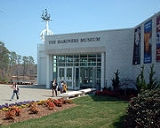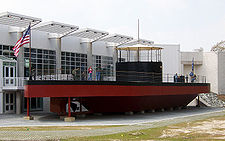
Mariners' Museum
Encyclopedia
The Mariners' Museum is located in Newport News, Virginia
. It is one of the largest maritime museum
s in the world as well as being the largest in North America.
, son of Collis P. Huntington
, a railroad builder who brought the Chesapeake and Ohio Railway
to Warwick County, Virginia
, and who founded the City of Newport News, its coal
export facilities, and Newport News Shipbuilding
in the late 19th century.
Archer and his wife, the sculptor Anna Hyatt Huntington
, acquired 800 acres (3.2 km²) of land that would come to hold 61,000 square feet (5,700 m²) of exhibition galleries, a research library, a 167 acre (676,000 m²) lake, a five mile (8 km) shoreline trail with fourteen bridges, and over 35,000 maritime artifacts from around the globe. After acquisition took place, the first two years were devoted to creating and improving a natural park and constructing a dam to create Lake Maury
, named after the nineteenth-century Virginia oceanographer Commodore Matthew Fontaine Maury
.
. The museum holds an important collection of paintings and drawings by marine artist James Bard
. The museum offers educational programs for all ages, a large research library and archives, as well as publications and Internet resources for teachers.
 The Mariners' Museum is home to the U.S.S. Monitor Center. In 1973, the wreck of the ironclad U.S.S. Monitor
The Mariners' Museum is home to the U.S.S. Monitor Center. In 1973, the wreck of the ironclad U.S.S. Monitor
, made famous in the Battle of Hampton Roads
in 1862 during the American Civil War
was located on the floor of the Atlantic Ocean
about 16 miles southeast of Cape Hatteras
, North Carolina
. The wreck site was designated as the United States' first national marine sanctuary. Monitor Sanctuary is the only one of the thirteen national marine sanctuaries created to protect a cultural resource, rather than a natural resource.
The Monitor National Marine Sanctuary
is now under the supervision of the U.S. National Oceanic and Atmospheric Administration
. Many artifacts from Monitor, including her innovative turret
, propeller, anchor, engine and some personal effects of the crew, have been brought to the museum. For several years, they were conserved in special tanks to stabilize the metal. The new U.S.S. Monitor Center officially opened on March 9, 2007, and a full-scale replica of the Monitor, the original recovered turret, and many artifacts and related items are now on display. Current efforts are focused on restoring the engine.
Newport News, Virginia
Newport News is an independent city located in the Hampton Roads metropolitan area of Virginia. It is at the southeastern end of the Virginia Peninsula, on the north shore of the James River extending southeast from Skiffe's Creek along many miles of waterfront to the river's mouth at Newport News...
. It is one of the largest maritime museum
Maritime museum
A maritime museum is a museum specializing in the display of objects relating to ships and travel on large bodies of water...
s in the world as well as being the largest in North America.
History
The museum was founded in 1932 by Archer Milton HuntingtonArcher M. Huntington
Archer Milton Huntington was the son of Arabella Huntington and the stepson of railroad magnate and industrialist Collis P. Huntington...
, son of Collis P. Huntington
Collis P. Huntington
Collis Potter Huntington was one of the Big Four of western railroading who built the Central Pacific Railroad as part of the first U.S. transcontinental railroad...
, a railroad builder who brought the Chesapeake and Ohio Railway
Chesapeake and Ohio Railway
The Chesapeake and Ohio Railway was a Class I railroad formed in 1869 in Virginia from several smaller Virginia railroads begun in the 19th century. Led by industrialist Collis P...
to Warwick County, Virginia
Warwick County, Virginia
Warwick County was a county in Southeast Virginia that was created from Warwick River Shire, one of eight created in the Virginia Colony in 1634. It became the City of Warwick on July 16, 1952...
, and who founded the City of Newport News, its coal
Coal
Coal is a combustible black or brownish-black sedimentary rock usually occurring in rock strata in layers or veins called coal beds or coal seams. The harder forms, such as anthracite coal, can be regarded as metamorphic rock because of later exposure to elevated temperature and pressure...
export facilities, and Newport News Shipbuilding
Northrop Grumman Newport News
Newport News Shipbuilding , originally Newport News Shipbuilding and Drydock Company , was the largest privately-owned shipyard in the United States prior to being purchased by Northrop Grumman in 2001...
in the late 19th century.
Archer and his wife, the sculptor Anna Hyatt Huntington
Anna Hyatt Huntington
Anna Vaughn Hyatt Huntington was an American sculptor.-Life and career:Huntington was born in Cambridge, Massachusetts. Her father, Alpheus Hyatt, was a professor of paleontology and zoology at Harvard University and MIT, and served as a contributing factor to her early interest in animals and...
, acquired 800 acres (3.2 km²) of land that would come to hold 61,000 square feet (5,700 m²) of exhibition galleries, a research library, a 167 acre (676,000 m²) lake, a five mile (8 km) shoreline trail with fourteen bridges, and over 35,000 maritime artifacts from around the globe. After acquisition took place, the first two years were devoted to creating and improving a natural park and constructing a dam to create Lake Maury
Lake Maury
Lake Maury is a reservoir which was created as part of the natural park on the grounds of the Mariners' Museum located in the independent city of Newport News in the Hampton Roads region of southeastern Virginia....
, named after the nineteenth-century Virginia oceanographer Commodore Matthew Fontaine Maury
Matthew Fontaine Maury
Matthew Fontaine Maury , United States Navy was an American astronomer, historian, oceanographer, meteorologist, cartographer, author, geologist, and educator....
.
Artifacts, paintings, models
The Museum’s collection totals approximately 35,000 artifacts, of which approximately one-third are paintings and two-thirds are three-dimensional objects. The scope of the Museum's collection is international. Included are 10 permanent galleries, changing and traveling exhibits, and virtual galleries available through the museum website. The collection of over 600,000 prints and 35,000 maritime artifacts is international in scope and includes miniature ship models, scrimshaw, maritime paintings, decorative arts, carved figureheads, working steam engines, and the world's only known existing Kratz-built steam calliopeCalliope (music)
A calliope is a musical instrument that produces sound by sending a gas, originally steam or more recently compressed air, through large whistles, originally locomotive whistles....
. The museum holds an important collection of paintings and drawings by marine artist James Bard
James Bard
James Bard was a marine artist of the 19th century. He is known for his paintings of watercraft, particularly of steamboats. His works are sometimes characterized as naïve art. Although Bard died poor and almost forgotten, his works have since become valuable...
. The museum offers educational programs for all ages, a large research library and archives, as well as publications and Internet resources for teachers.
U.S.S. Monitor Center

USS Monitor
USS Monitor was the first ironclad warship commissioned by the United States Navy during the American Civil War. She is most famous for her participation in the Battle of Hampton Roads on March 9, 1862, the first-ever battle fought between two ironclads...
, made famous in the Battle of Hampton Roads
Battle of Hampton Roads
The Battle of Hampton Roads, often referred to as either the Battle of the Monitor and Merrimack or the Battle of Ironclads, was the most noted and arguably most important naval battle of the American Civil War from the standpoint of the development of navies...
in 1862 during the American Civil War
American Civil War
The American Civil War was a civil war fought in the United States of America. In response to the election of Abraham Lincoln as President of the United States, 11 southern slave states declared their secession from the United States and formed the Confederate States of America ; the other 25...
was located on the floor of the Atlantic Ocean
Atlantic Ocean
The Atlantic Ocean is the second-largest of the world's oceanic divisions. With a total area of about , it covers approximately 20% of the Earth's surface and about 26% of its water surface area...
about 16 miles southeast of Cape Hatteras
Cape Hatteras
Cape Hatteras is a cape on the coast of North Carolina. It is the point that protrudes the farthest to the southeast along the northeast-to-southwest line of the Atlantic coast of North America...
, North Carolina
North Carolina
North Carolina is a state located in the southeastern United States. The state borders South Carolina and Georgia to the south, Tennessee to the west and Virginia to the north. North Carolina contains 100 counties. Its capital is Raleigh, and its largest city is Charlotte...
. The wreck site was designated as the United States' first national marine sanctuary. Monitor Sanctuary is the only one of the thirteen national marine sanctuaries created to protect a cultural resource, rather than a natural resource.
The Monitor National Marine Sanctuary
Monitor National Marine Sanctuary
Monitor National Marine Sanctuary is the site of the wreck of the USS Monitor, one of the most famous shipwrecks in U.S. history. It was designated as the country's first national marine sanctuary on January 30, 1975, and is the only one of the thirteen national marine sanctuaries created to...
is now under the supervision of the U.S. National Oceanic and Atmospheric Administration
National Oceanic and Atmospheric Administration
The National Oceanic and Atmospheric Administration , pronounced , like "noah", is a scientific agency within the United States Department of Commerce focused on the conditions of the oceans and the atmosphere...
. Many artifacts from Monitor, including her innovative turret
Turret
In architecture, a turret is a small tower that projects vertically from the wall of a building such as a medieval castle. Turrets were used to provide a projecting defensive position allowing covering fire to the adjacent wall in the days of military fortification...
, propeller, anchor, engine and some personal effects of the crew, have been brought to the museum. For several years, they were conserved in special tanks to stabilize the metal. The new U.S.S. Monitor Center officially opened on March 9, 2007, and a full-scale replica of the Monitor, the original recovered turret, and many artifacts and related items are now on display. Current efforts are focused on restoring the engine.
External links
- http://www.MarinersMuseum.org/
- http://www.marinersmuseum.org/uss-monitor-center/uss-imonitori-center

